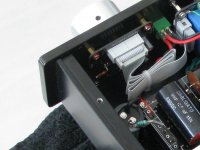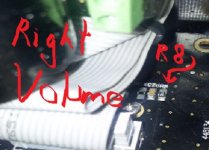Update on using the fixed resistor instead of the multiturn trimmers for setting anode voltage... As expected there is zero drift, and the preamp is as quiet as most non dht preamps... Nice 🙂
Update on using the fixed resistor instead of the multiturn trimmers for setting anode voltage... As expected there is zero drift, and the preamp is as quiet as most non dht preamps... Nice 🙂
Excellent news.
May I ask a beginner question? Is this drift something that happens with the stock regulators, or is it just the Coleman modded regulators that drift? 😱
You have short Tram II-upgrade-memory 😉 If you look back a few posts you will notice that the drift is on the 120V DC anode voltage due to the multiturn trimmer on the CCS module. You will also notice your own comments on the fixed resistor, so I think you have read it 😎
Last edited:
Ive shot some temperature readings of the Tram2 guts with the base off.
I got bit of a surprise with 69C on the standard regulator transistor body or whatever the thing is in the middle of the heat sink. That was just running 45's with the base off and 26C ambient temperature.
I wanted to try my 2A3 RCA VT95 2A3 that finally arrived so I committed sacrilege put a fan under the Tram2. Running the 2A3's the temperature came down to 39C. That was with the 120mm computer fan on 2/3 power so I turned the fan to the lowest setting. The temp is now to 46C which Im happy with. The fan is vibration and noise free as its just idling running on the lowest setting and reduced voltage via a linear power supply. I hate to think how hot the regulator would get on a still hot day with 2A3's in it and the base on.
The 2a3"s were no noisier then the NOS 45's with a quiet hum with ear to speaker. I put an old tin can over the 2A3's supported on blutac to allow an air gap for draft. The hum went completely with no need to have an earthing wire on the old can.
I like the 2A3's I got with a bigger more dynamic sound as the initially impression while still maintaining the .timbre richness of the 45's
I also dimmed the front panel LED;s by filling the holes with blutac. Now they glow faintly.
See I can do DIY. Now I just have to work out what that CCS thingy does. 😱
An externally hosted image should be here but it was not working when we last tested it.
I got bit of a surprise with 69C on the standard regulator transistor body or whatever the thing is in the middle of the heat sink. That was just running 45's with the base off and 26C ambient temperature.
I wanted to try my 2A3 RCA VT95 2A3 that finally arrived so I committed sacrilege put a fan under the Tram2. Running the 2A3's the temperature came down to 39C. That was with the 120mm computer fan on 2/3 power so I turned the fan to the lowest setting. The temp is now to 46C which Im happy with. The fan is vibration and noise free as its just idling running on the lowest setting and reduced voltage via a linear power supply. I hate to think how hot the regulator would get on a still hot day with 2A3's in it and the base on.
The 2a3"s were no noisier then the NOS 45's with a quiet hum with ear to speaker. I put an old tin can over the 2A3's supported on blutac to allow an air gap for draft. The hum went completely with no need to have an earthing wire on the old can.
I like the 2A3's I got with a bigger more dynamic sound as the initially impression while still maintaining the .timbre richness of the 45's
I also dimmed the front panel LED;s by filling the holes with blutac. Now they glow faintly.
See I can do DIY. Now I just have to work out what that CCS thingy does. 😱
Last edited:
Hi,
The Resistors are R8 & R11, original 390 Ohm.
They are one each on the actual controls section (with LED's and rotary encoder) of the PCB.
Ciao T
Instead of stuffing the holes with bluetac I suggest you change the resistors that set the level for the led's. I change them from 390 ohm to 2K2
Instead of stuffing the holes with blutac I suggest you change the resistors that set the level for the led's. I change them from 390 ohm to 2K2
Yep - I read your posts and T.L.'s but when I looked to do the same thing I couldn't see those resistors. I think they hid them on the wrong side of the board next to the front panel blocking easy access and I further suspect they are those little surface mount resistors which look hard to de-solder? It looked too hard for me anyway. Im pretty handy with blutac though and I bet my Tram2 is unique now between the old cans and the blutac. 🙂
I don't know how to say this, but the bluetac solution is... hmmm... crap..! 😉 If you have too bright bulbs in your lamps, do you then cover the bulbs with a coat of bluetac? Or do you put in bulbs that are less bright? The resistors are on the ''right'' side of the pcb, and the smd resistors are very easy to remove. Just heat them until they fall of, solder the leaded resistors in instead. 5-10 minute project... In this picture you can see the location of the resistor (red resistor, leaded type, just to the left of the grey connector).
Attachments
Last edited:
Thanks Morten for the beginner level instructions which I needed.
You are right the blutac is very crude compared to your elegant mod.
Ive spotted the R8 surface mounted resistor now using the camera as a magnifier and think even I might be able to follow your led now. This might inspire others to have a go as well, now we can see how achievable it is.
You are right the blutac is very crude compared to your elegant mod.
Ive spotted the R8 surface mounted resistor now using the camera as a magnifier and think even I might be able to follow your led now. This might inspire others to have a go as well, now we can see how achievable it is.
Attachments
My TRAM is for SALE now in German Audiomarkt.
Triode Technology / TRAM MK2 (Gebrauchtgerät) Röhren-Vorverstärker Interessantes Angebot !
Just contact me regarding any questions.
Triode Technology / TRAM MK2 (Gebrauchtgerät) Röhren-Vorverstärker Interessantes Angebot !
Just contact me regarding any questions.
My TRAM is for SALE now in German Audiomarkt.
Triode Technology / TRAM MK2 (Gebrauchtgerät) Röhren-Vorverstärker Interessantes Angebot !
Just contact me regarding any questions.
Just curious, what makes you sell the Tram II? And what will your new preamp be?
Looking around at the Internet it seems that some prefer the 5R4 type rectifiers to the 5U4 types. I just bought one of these Philips 5R4GYS rectifiers to try in the Tram II. Even if it's not a direct replacement for the 5U4G it seems to work OK... One thing though is, that the first capacitor after the rectifier should be max 4uF with these. This is somewhat lower value than for the 5U4G. Does anyone know the value of the first cap on the FCUPS module..!?
This is the first rectifier I try where there is a noticeable difference in sound. Before the Philips I used the Valve Art 274 rectifier, and the Philips is noticeably smoother and slightly warmer in the mid range and lower treble. It's not so warm that it becomes boring, and it does not lack transparency... Very nice, and not a lot of money.
This is the first rectifier I try where there is a noticeable difference in sound. Before the Philips I used the Valve Art 274 rectifier, and the Philips is noticeably smoother and slightly warmer in the mid range and lower treble. It's not so warm that it becomes boring, and it does not lack transparency... Very nice, and not a lot of money.
Attachments
Last edited:
Morten, the first two Obbligato caps FCUPS module are 10uf each. As the 5U4G can take 40uf, 20uf as the first cap is safe.
Go to the dark side and try a GEC U52, brown base with D getter. It's just like buying the Full Music 2A3 SE.
Go to the dark side and try a GEC U52, brown base with D getter. It's just like buying the Full Music 2A3 SE.
Hi Peter, Yes I notice from the board, that it could seem like the two first 10uF are the input caps. I will measure the capacitance from the rectifier pin 8 to ground to check/verify.
After I asked the question I talked to someone I know who has half a life experience with tubes. It should not be critical with the bigger cap compared to the 4uF rating on the 5R4 rectifiers. He believe -worse case- that the expected life will be down from around 5000 hours to around 3-4000 hours. I can live with that since the tubes cost a lot less than the good quality 5U4 and U52.
I told him about what I heard from the NOS Philips 5R4, and he agress and say that he belive they sound as good, or maybe even a bit better than the best 5U4 or U52. But the 5R4 types are not hyped (yet) in the audio world, so prices are much lower (yet). I have ordered some more to get a few of them before the prices go up. I ordered one more of the Philips and also a Brimar...
No hyped and very expensive dark side for me 😉 You know me, I hate paying a ton of money for hyped NOS tubes...
After I asked the question I talked to someone I know who has half a life experience with tubes. It should not be critical with the bigger cap compared to the 4uF rating on the 5R4 rectifiers. He believe -worse case- that the expected life will be down from around 5000 hours to around 3-4000 hours. I can live with that since the tubes cost a lot less than the good quality 5U4 and U52.
I told him about what I heard from the NOS Philips 5R4, and he agress and say that he belive they sound as good, or maybe even a bit better than the best 5U4 or U52. But the 5R4 types are not hyped (yet) in the audio world, so prices are much lower (yet). I have ordered some more to get a few of them before the prices go up. I ordered one more of the Philips and also a Brimar...
No hyped and very expensive dark side for me 😉 You know me, I hate paying a ton of money for hyped NOS tubes...
Last edited:
Thanks Desmo for a very interesting lead on rectifier choices. The sound you described with warmer lower treble and retaining transparency is just what I like. So Im very interested in trying these. The Philips 5R4GYS internals looks like a DHT too?
Y0FdzcBP8Mh2lKLw~~60_57.JPG)
Knowing so little about electronics I have concerns that the 5R4GYS might run too far out of specification for the Tram2 in ways other then the capacitance issue. What do you think of these opinions?
"can you substitute 5U4 with 5R4? "
heater current. "the 5U4 draws 3 amps @5v while the 5R4 draws 2amps." Is this a good thing meaning the Tram2 will run cooler?
current handling capacity. "5U4 can handle up to 1000ma while the 5R4 can only handle 250ma."
voltage drop difference "The 5R4 has a voltage drop of 67V. The 5U4 has a drop of 58V. Depending on where the B+ is the tube swap might take voltages out of spec."
My impression is that the 5R4 is a lower spec'ed rectifier and is markedly out performed by the 5U4. Is it possible the softer sound signature of the 5R4 is simply a fault that is caused by its inability to provide enough power to support the dynamic peak loads?
Thanks
Knowing so little about electronics I have concerns that the 5R4GYS might run too far out of specification for the Tram2 in ways other then the capacitance issue. What do you think of these opinions?
"can you substitute 5U4 with 5R4? "
heater current. "the 5U4 draws 3 amps @5v while the 5R4 draws 2amps." Is this a good thing meaning the Tram2 will run cooler?
current handling capacity. "5U4 can handle up to 1000ma while the 5R4 can only handle 250ma."
voltage drop difference "The 5R4 has a voltage drop of 67V. The 5U4 has a drop of 58V. Depending on where the B+ is the tube swap might take voltages out of spec."
My impression is that the 5R4 is a lower spec'ed rectifier and is markedly out performed by the 5U4. Is it possible the softer sound signature of the 5R4 is simply a fault that is caused by its inability to provide enough power to support the dynamic peak loads?
Thanks
Last edited:
My only concern regarding spec is the one you don't mention with the input cap rating, and as mentioned the guy I talked who knows tubes says it does not mean much.
I have not said it sound soft..! This is your own interpretation... I have said it sounds smoother and slightly warmer. It's not soft by any means, I would say that dynamics are the same as before, and the sound is a s firm and punchy as ever. What is improved is, that they appear smoother, less grain, slightly warmer in the midrange and lower treble and that the transparency is amazing. I listened some more last night, and transparency is quite a lot improved, I would also say, that dynamics in the treble range is improved. When I hear stuff, that BOTH appear a bit darker AND have improved transparency then I take notice...
I have not said it sound soft..! This is your own interpretation... I have said it sounds smoother and slightly warmer. It's not soft by any means, I would say that dynamics are the same as before, and the sound is a s firm and punchy as ever. What is improved is, that they appear smoother, less grain, slightly warmer in the midrange and lower treble and that the transparency is amazing. I listened some more last night, and transparency is quite a lot improved, I would also say, that dynamics in the treble range is improved. When I hear stuff, that BOTH appear a bit darker AND have improved transparency then I take notice...
Last edited:
Thanks Morten for that great clarification.
Ive ordered three of what I hope will be Philips 5R4GYS rectifiers off eBay - wish me luck 🙂
Ive ordered three of what I hope will be Philips 5R4GYS rectifiers off eBay - wish me luck 🙂
Last edited:
- Status
- Not open for further replies.
- Home
- DIY HiFi Supply
- DHT OTL Linestage - Tram 2


